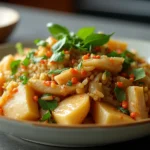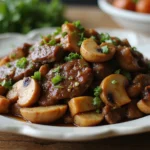As the Lunar New Year approaches, vibrant celebrations filled with color and flavor come to life, and nothing embodies this spirit better than vegan Chinese New Year recipes.
These dishes not only offer a feast for the senses but also carry rich cultural significance that connects generations and families.
The delightful blend of fresh vegetables, aromatic spices, and umami flavors creates a joyful dining experience that is both festive and delicious.
Whether you’re vegan or simply looking to add more plant-based options to your celebrations, these recipes will ensure your New Year feast is both colorful and memorable.
The History and Cultural Significance
• Vegan Chinese New Year recipes have roots in ancient Chinese traditions where food symbolizes prosperity, luck, and happiness.
• Over centuries, these dishes have adapted to include a variety of plant-based ingredients, reflecting the growing popularity of veganism and sustainability.
• Traditionally, these recipes are prepared for family reunions during the Lunar New Year, signifying unity and togetherness.
• The vibrant colors of these dishes are believed to attract good fortune, making them essential during the celebrations.
Recipe Overview
Nutritional Information (per serving)
Ingredients
Essential Equipment Guide
Wok: A traditional wok is essential for achieving the high heat necessary for stir-frying, which allows for quick cooking while retaining the crunch of vegetables. Look for a carbon steel wok that can withstand high temperatures and has a curved bottom for even heat distribution.
Steamer Basket: A bamboo or metal steamer basket is important for steaming dumplings or vegetables, helping to keep them moist and flavorful. Ensure it fits well over your pot and has enough space for steaming multiple layers.
Chef’s Knife: A sharp chef’s knife is crucial for efficiently chopping and slicing vegetables into uniform pieces, which ensures even cooking. Choose a knife that feels comfortable in your hand and is well-balanced.
Preparation Methods
Stir-frying: This quick cooking method is essential for maintaining the freshness and texture of the vegetables. Use high heat and keep the ingredients moving in the wok to prevent burning and ensure even cooking.
Steaming: Steaming vegetables preserves their nutrients and vibrant colors. Make sure not to overcrowd the steamer basket, allowing steam to circulate freely for even cooking.
Marinating: Marinating your vegetables or tofu in soy sauce and spices enhances their flavor. Allow them to marinate for at least 15-30 minutes for the best results.
Step 1: Prepare Ingredients
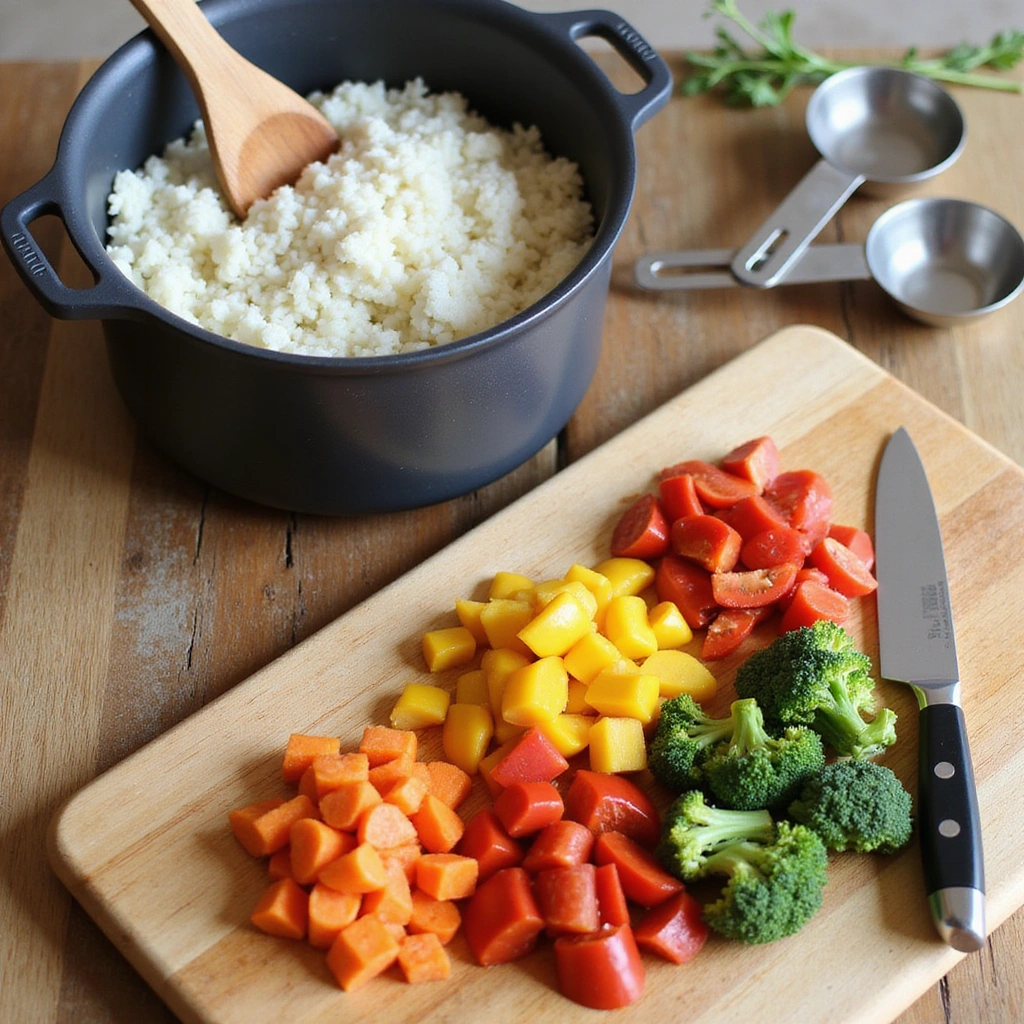
Begin by washing and chopping all vegetables into uniform sizes for even cooking.
Measure out the rice and set it to cook according to package instructions.
Have all seasonings prepped and ready to go to streamline the cooking process.
Using a sharp knife ensures clean cuts, which helps maintain the vegetables’ structure.
Step 2: Marinate Tofu
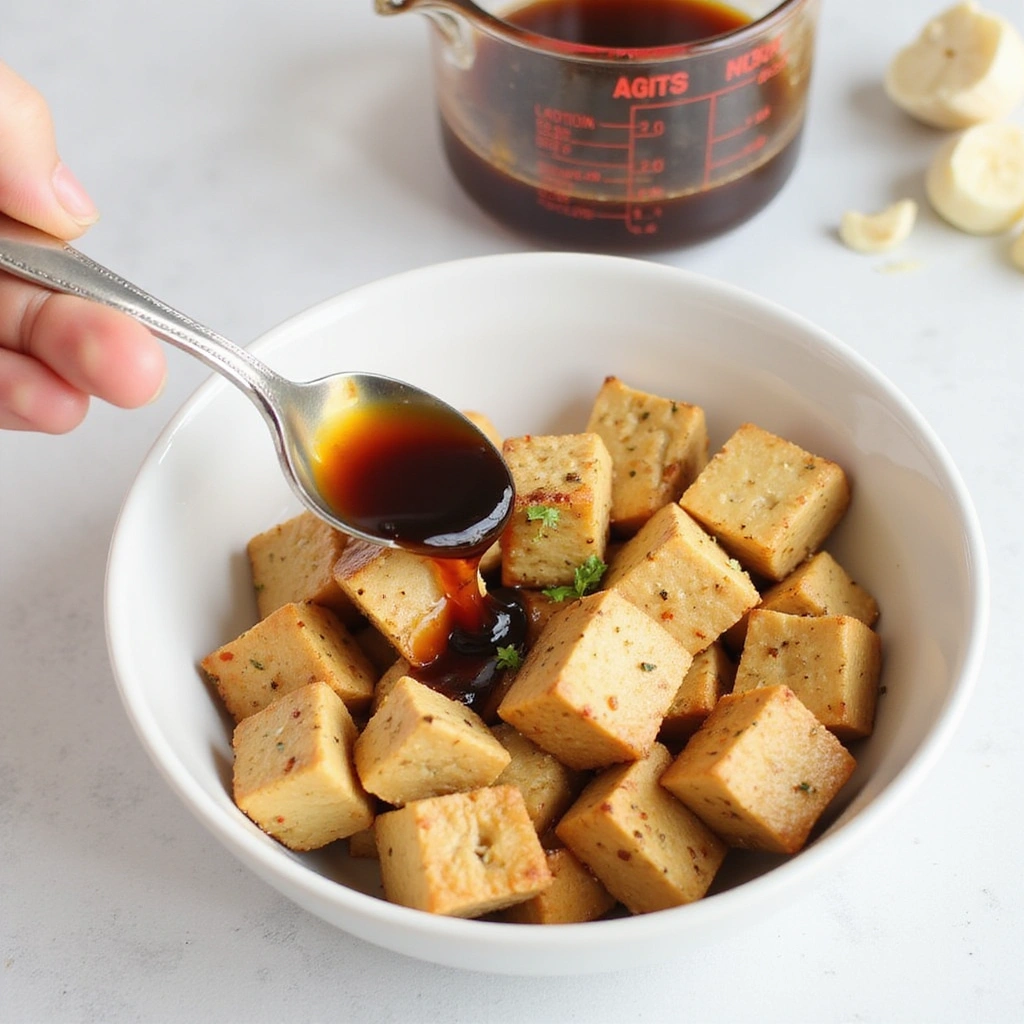
Cut the tofu into bite-sized cubes and place them in a bowl.
Pour soy sauce, sesame oil, ginger, and garlic over the tofu and gently toss to coat.
Let the tofu marinate for at least 15 minutes to absorb the flavors.
Marinating helps develop a deeper flavor profile, enhancing the overall dish.
Step 3: Stir-fry Vegetables

Heat a wok over high heat and add the oil, swirling it to coat the surface.
Once the oil is shimmering, add the chopped vegetables starting with the carrots and bell peppers.
Stir-fry for about 3-4 minutes until they start to soften but still retain their crunch.
Keep stirring continuously to prevent burning and to achieve a nice char.
Step 4: Add Tofu

Once the vegetables are tender-crisp, add the marinated tofu to the wok.
Gently fold the tofu into the vegetables and cook for an additional 5 minutes.
Watch for the tofu to brown slightly on the edges, which adds flavor.
Be careful not to break the tofu pieces while mixing.
Step 5: Season the Dish
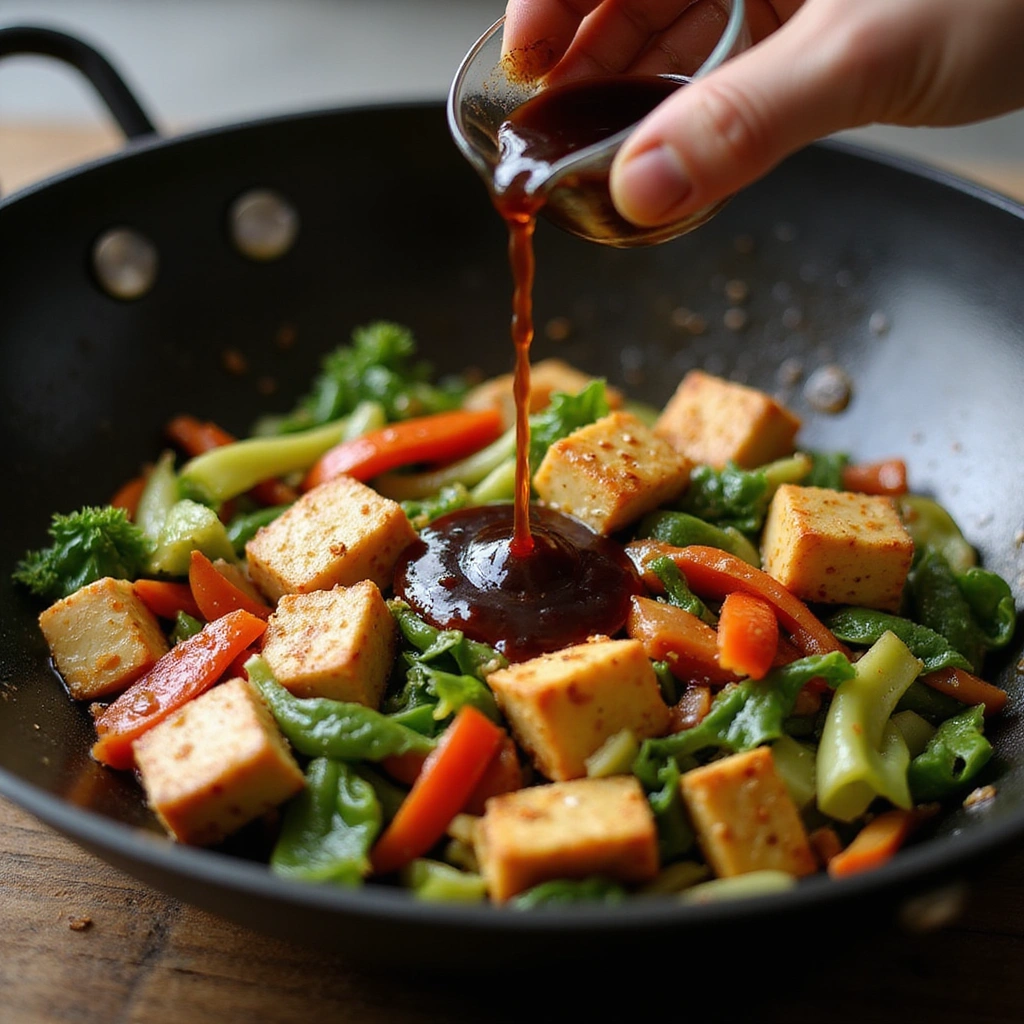
Drizzle additional soy sauce over the stir-fry and toss to combine all flavors.
Taste the dish and adjust seasonings if necessary, adding more ginger or garlic as desired.
The goal is to achieve a well-balanced flavor that highlights the fresh ingredients.
Don’t hesitate to customize based on your taste preferences.
Step 6: Serve with Rice

Fluff the cooked jasmine rice with a fork and transfer it to a serving dish.
Spoon the stir-fried vegetable and tofu mix over the rice.
Consider garnishing with sesame seeds or chopped green onions for added flavor and presentation.
This final touch adds not only taste but also visual appeal.
Step 7: Garnish and Enjoy

Finish the dish by sprinkling sesame seeds and freshly chopped green onions over the top.
Serve immediately while hot, allowing everyone to enjoy the vibrant flavors.
Pair with a side of pickled vegetables for an authentic touch.
The combination of textures and flavors will surely impress your guests.
Step 8: Clean Up

After enjoying your meal, promptly wash the cooking equipment to avoid residue buildup.
Soak the wok in warm soapy water if needed to loosen any food particles.
Organize your kitchen to maintain a pleasant cooking environment for next time.
Cleaning as you go makes the entire cooking experience more enjoyable.
Critical Timing and Temperature Guide
Stir-frying Vegetables: Aim for a cooking time of 3-4 minutes on high heat. Look for vibrant colors and tender-crisp texture. Avoid overcooking to maintain their freshness.
Marinating Tofu: Allow the tofu to marinate for at least 15-30 minutes. The longer it marinates, the more flavor it absorbs. Don’t rush this step for optimal taste.
Cooking Rice: Jasmine rice typically requires about 15-20 minutes of cooking time. Ensure the water is fully absorbed before fluffing. Undercooking may result in a chewy texture.
Pro Tips for Vegan Chinese New Year Recipes Colorful Festive And Delicious
• Ingredient Selection: Use fresh, seasonal vegetables for the best flavor and nutrition. High-quality tofu will absorb flavors better and have a firmer texture.
• Preparation Secret: Pre-cook the rice the day before and let it cool to enhance texture when stir-frying.
• Temperature Management: Ensure your wok is extremely hot before adding ingredients to achieve the perfect stir-fry.
• Texture Enhancement: For added crunch, consider adding nuts like cashews or peanuts in the final stages of cooking.
• Flavor Layering: Incorporate a splash of rice vinegar at the end for a tangy finish that brightens the dish.
• Make-Ahead Strategies: Chop vegetables and marinate tofu a day in advance to save time on cooking day.
• Restaurant-Quality Finishing Touches: Drizzle a bit of chili oil or a sprinkle of freshly chopped herbs before serving for visual appeal.
• Equipment Optimization: Make sure your wok is seasoned well for non-stick cooking and easy cleanup.
Troubleshooting Common Issues
• Too Much Liquid in Stir-Fry: This usually occurs from overcooking vegetables or not drying tofu properly. To fix, increase the heat and stir-fry longer to evaporate excess moisture.
• Vegetables Overcooked: If your vegetables are too soft, reduce cooking time in future attempts. Always have everything prepped and ready to avoid delays.
• Flavors Not Balanced: If the dish lacks flavor, consider adding more seasoning during cooking. Taste regularly as you go.
• Rice Too Sticky: This can happen if the rice is overcooked or too much water is used. Rinse the rice before cooking to remove excess starch.
• Tofu Crumbles: If your tofu breaks apart, it may be too soft. Choose firmer tofu for stir-frying, and handle gently during cooking.
Variations and Regional Differences
• Sichuan Style: This version incorporates spicy chili paste and Sichuan peppercorns, adding a fiery kick to the flavors.
• Hong Kong Style: Often features a sweeter profile with the addition of hoisin sauce and a variety of leafy greens.
• Shanghai Style: Includes a mix of mushrooms and bamboo shoots, offering an earthy depth to the dish.
• Modern Interpretations: Some chefs are experimenting with quinoa instead of rice and adding trendy ingredients like avocado for a contemporary twist.
Food Science Behind the Recipe
• Maillard Reaction: This browning reaction occurs when proteins and sugars in the tofu are exposed to high heat, creating complex flavors. Understanding this helps in timing your cooking to achieve that perfect golden-brown color.
• Emulsification: The blending of oils and water-based ingredients in the sauces creates a stable mixture that coats each ingredient evenly, enhancing flavor distribution.
• Steam Cooking: Steaming vegetables allows them to cook gently while retaining moisture and nutrients, making them vibrant and crisp.
Frequently Asked Questions
What’s the most common mistake people make when preparing vegan Chinese New Year recipes? Many forget to properly season and taste as they cook, leading to bland dishes. Always taste and adjust seasonings throughout the cooking process.
Can I prepare components of this dish in advance? Yes, you can chop vegetables and marinate tofu a day ahead. Store them in airtight containers in the refrigerator.
How do I adapt this recipe for dietary restrictions? To make it gluten-free, use tamari instead of soy sauce and ensure your rice is gluten-free.
What’s the best way to store and reheat leftovers? Store leftovers in an airtight container in the fridge for up to 3 days. Reheat in a pan over medium heat to maintain texture.
Can I freeze this dish? Yes, but it’s best to freeze the stir-fry mixture without the rice. Thaw overnight in the fridge and reheat thoroughly before serving.
What wine or beverages pair best with this dish? A light, fruity white wine like Riesling complements the flavors beautifully. Alternatively, serve with jasmine tea for a traditional touch.
How can I scale this recipe up for a crowd? Simply multiply each ingredient by the number of servings desired, but be cautious with cooking times as larger batches may need longer to cook evenly.
What side dishes complement this recipe best? Serve with spring rolls or a light cucumber salad to balance the meal.
How do professional chefs elevate this dish for restaurant service? They often focus on presentation, using techniques like stacking ingredients and adding microgreens for a colorful finish.
Serving and Presentation Guide
• Traditional Presentation: Serve in large family-style bowls, allowing guests to help themselves, with a side of pickled vegetables for added flavor.
• Modern Plating Ideas: Plate the stir-fry in individual bowls, layering the rice and topping with the vegetable mix, garnished attractively.
• Accompaniment Suggestions: Pair with a side of steamed dumplings or a fresh salad to enhance the meal.
• Special Occasion Presentation: Use decorative serving dishes and arrange the food artistically, adding festive elements like red and gold accents.
Conclusion
As you embark on preparing these vegan Chinese New Year recipes, remember that every dish tells a story of tradition and celebration.
May your table be filled with vibrant colors, delicious flavors, and the warmth of family and friends.
I encourage you to dive into this culinary adventure and create lasting memories this New Year.





